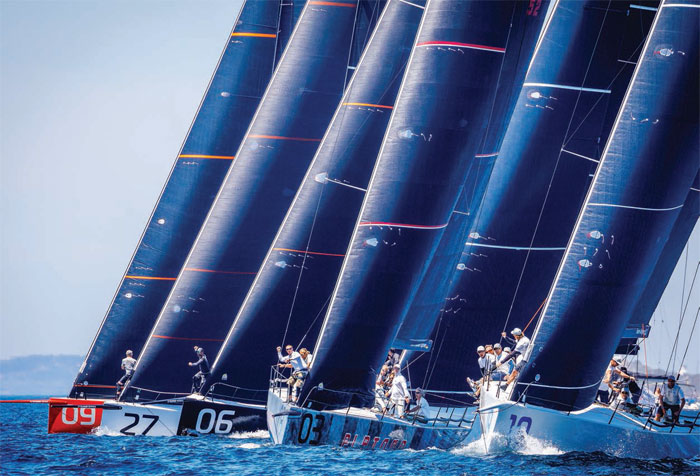

In almost every respect, as a new venue to the 52 Super Series, Baiona and a first trip to Galicia proved a triumph. Flanking a tricky racing arena the lush, green hills and islands were a welcome contrast to the dry, dusty backdrops of the Mediterranean in summer.
There was a good range of wind conditions over a flatwater racetrack which was complex, dynamic and hard to read. A tactician’s regatta. And ashore a fine historic yacht club that was always both friendly and welcoming. The TP52 owners and teams loved it.
If it maybe seemed like the old order resumed as Quantum Racing ran out winners ahead of Platoon and Phoenix, there were other signs that are encouraging for the future of the circuit which of course will only be determined by maintaining a congregation of passionate, happy owners. To that end it was massively heartening to witness the regatta of the 2015-launched Vayu and the Whitcraft family.
With five family members onboard the Thai crew shared the lead after the first day and maintained a strong performance through the week, proving that in the lighter wind ranges a well-sailed, oldergeneration boat can do very well. That they are part of the Quantum team support package, along with Gladiator, certainly flattens out the learning curve – but bear in mind they only first ‘met’ their brand new quiver of Quantum sails a few days before Race 1. Chapeau!
James Lyne, Quantum coach and guru, notes, ‘Vayu, that generation of boat is really interesting as they are really fast downwind relative to the 2018 boats. They are smaller boats with a little less wetted area and upwind in sub-10kt they were also super-competitive.
‘Talking to the Vayu guys, they were pleasantly surprised with how things turned out – they have such a willingness to learn and I expect to see them take more good boats over the year.’
Asked if there is scope for more entry-level 52s to join the Quantum programme, Lyne responds, ‘We can do that, it would take more resources, but we can do that. They showed the path forwards that we can offer, you don’t have to have been on the circuit for 10 years. The Quantum IP that we provide is strong and that is what Vayu showed. They get the 10 years of condensed knowledge straightaway, removing a huge barrier to entry.’
And wearing one of the biggest smiles, mostly, in Baiona was Tony Langley. The Gladiator leader was delighted to put a win on the board at the first regatta of the season. While Quantum stole the march at the top of the prize-list and are injecting speed, knowhow and most of all supporting data to the Vayu and Gladiator campaigns, a very strong Super Series debut by Doyle Sails saw them in second (Platoon) and fourth spots (Interlodge).
Platoon trimmer Ross Halcrow explains his own view on how luff structures and yarn layouts in the fleet might be influenced by the strong Doyle track record in this area. ‘There are mainly only minor changes in the sails themselves,’ Halcrow maintains, ‘the structured luff, call it what you like, is more about the different yarn files.
‘On these boats we have so much headstay tension and over the last few years we have ended up having more and more yarns in the luff anyway. The structured luff really comes into play when you are reaching rather than upwind-downwind. You can put yarns in multiple places – whether you are loading on the cunningham or not loading the cunningham, you can change the shape in different parts of the sail. It is personal preference how you want to use that structure in the sail to trim it but it’s a very powerful tool.
‘My preference on a boat where you can get lots of headstay tension is to place less reliance on the cunningham. But a lot of the time with the structured luff you see people using too much cunningham to try to get the shape they want. I do it differently…
‘The structured luff is really advantageous on the reaching sails where you can load up the structure and it then really pulls the sail forward and allows it to fly super well. But upwind with the headstay loads we carry we don’t see it flying forward. So I prefer instead to design the sail with a bit more entry for when you are under range. Then you don’t have to use cunningham to get the entry on it; so down range you are not using the cunningham so much and then up the range you use it to flatten out the sail in the conventional way.’
Doyle’s US-based designer David Armitage who trims on Interlodge works closely with Jordi Calafat on Platoon and Richard Bouzaid. For a first Super Series foray they were pretty happy with the 2nd for Platoon and 4th for Interlodge. Now having three premium brands fighting it out in this class will clearly accelerate evolution.
Armitage, who was 18 years with Quantum and is now in his second year with Doyle notes, ‘Some of the North teams do seem to be trying to copy what we have done with structured luff sails – but in truth we have not gone too hard in that direction to start with.
‘As we get deeper into the 52s we might push further in that direction but we did not want to start too far out on a limb. While the structured luff is good in a lot of applications it might not be completely accepted by every team. It’s a change of mindset in terms of the way you set the boat up. So we have come in with a relatively soft approach… the upwind sails in particular are much closer to what a standard upwind sail might look like.
‘Jibs are an evolution of what we had. As Interlodge is the ex-Azzurra we initially used a lot of the North sails that came with it last year and so those were quite different. The jibs were deeper in the head and a bit heavier. The shapes were a little different.
‘Our jibs are a little lighter overall and flatter in the head. But our mainsails are night and day better. To be honest we were amazed Azzurra did as well as they did with the mainsails they had! We really struggled to get them looking good and the shape was moving around a lot. So we are happy to have been able to go back to our membrane technology and the mainsails we have produced for this year are really, really nice.
‘So to have a trimmer like Rod Dawson, who has no connection with Doyle Sails, come in and be impressed at the start is good. Out of the bag we are very happy with these first mainsails.’
Keels, keels, keels
Three boats have new keel fins for 2022: Alegre and Phoenix have new fins from Botín while Quantum have been working with Iain Percy and the team at Artemis Technologies – but at a shifty, lightair venue on flat water it was too early to ascertain the small gains.
Indeed Tom Slingsby, tactician on Phoenix – which experienced observers thought was quickest all-round – reckoned, ‘It is interesting that the competition felt, as we felt onboard, that we’d lost a bit of the upwind edge we had last year. We may have lost a little upwind and gained a little downwind… but it was very hard to tell. We do feel Quantum has made a solid jump with their new fin.’
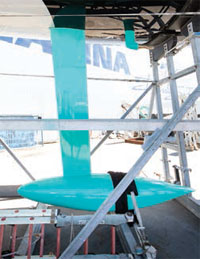
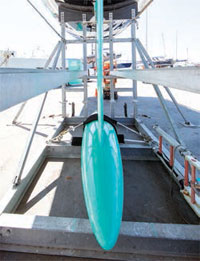
Above and below: Now wearing turquoise is Quantum 2022 – her new fin developed with Artemis Technologies. Wearing black is the original 2017 Botín fin on Gladiator. In elevation the new Quantum foil demonstrates more parallel leading and trailing edges and also features a shorter chord. To compensate for the reduction in area the Quantum fin is marginally fatter than its predecessor though there is still very likely to be a net reduction in wetted area. In the light conditions of Baiona Quantum lacked neither speed nor ‘bite’ upwind, and the reduced wetted surface can only have helped once around the first mark. Now the fleet moves to breezier venues when more will become clear
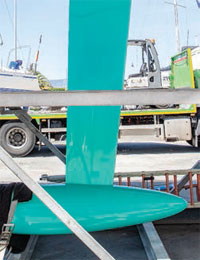
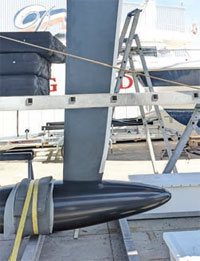
Certainly, Alegre showed well in spring training in Valencia and took a race in Baiona while Quantum’s victory speaks for itself. Adolfo Carrau of Botín opened up a little more after the regatta, explaining that so refined and similar are the boats now that they were prepared to take bigger – but carefully modelled – risks with new fins which represent a 180° change of section philosophy.
‘With the new appendages what we are after is better pre-start manoeuvring, which is difficult to assess. It is not straightline testing, it is more being able to, at low speed, have the flow reattach quickly and then off you go. Same out of manoeuvres. And being more forgiving, they should be very good at holding lanes too.
‘Overall it is all very subtle. But the change in section is not subtle at all, in fact it is pretty extreme. We went in a different direction and found speed,’ he smiles. ‘But now the teams must work on the humming as these more extreme foils are humming a lot!’
Carrau admits that, as usual, even with the latest-generation modelling tools there were nerves in the Santander studio: ‘The key when you make such a radical change is that you don’t go backwards. You must back yourself. But we were still nervous.
‘Of course when you make such big changes in design philosophy then you must validate them on the water! Here because the fleet is so tight we decided it was important to give the teams a bit more manoeuvrability so they could start better because 50 per cent of the race is there in the start. Then you have a conflict: when you want to improve your low speed you might damage your high speed… that is where the America’s Cup technical circus come to town!
‘With new tools and a new Cup team (Alinghi) we have new brains too, so after a lot of work we presented something we were happy with… The interesting thing was we gained in a straight line too!!
‘The dominant drag is the hull plus the overall balance of the boat, and when these things don’t change then with a new fin, if it’s similar in area and the depth is fixed, if you get it right you find maybe a few extra metres which in this fleet makes all the difference.
‘But this time there was no point making baby steps. The gains are still very small but here 1,2,3 seconds a mile allows you to get your nose out and then hopefully extend.’
The alliance between Quantum and Artemis Technologies started last season and is part of their hallmark no-stone-unturned approach. No stranger to the TP52 fleet, Percy comments, ‘Our Applied Technologies side of the business has really enjoyed the optimisation process with Quantum Racing. We began this project in late 2021 with the goal of looking for incremental gains to increase Quantum’s performance around the racecourse, in particular identifying changes to their hydro package. The Artemis optimisation process uses state-of-the-art modelling tools, including Fluid Structure Interaction, section shape optimisation and detail optimisation using Rans CFD.
‘It was an iterative process and relied heavily on the successful combining of sailing knowledge, supplied data and the skillsets from Quantum combined with our own optimisation tools.’
The marriage between Quantum’s bank of performance data and Artemis’s tools seemed to bear fruit immediately. Percy: ‘To achieve the ultimate optimisation using Quantum’s data and our tools guaranteed something that would have been faster in the races within the chosen data set. It is not limited to “how” the boat was sailed, more what happened in the races.
‘Sensitivities to a spectrum of sailing moments/techniques/ set-ups, and other variables like water turbulence level, are then considered; some of this sensitivity analysis comes from Artemis’s existing knowledge/tools and some through collaborative objective- setting by Artemis Technologies and Quantum Racing.’
It will certainly be later in the season, probably after Portals and even Scarlino, before a more comprehensive performance profile of the fleet can be drawn up. But in the meantime with rule stability set to continue and good technical support available in the fleet it is a good time to get involved and just go racing. As Thailand’s Vayu team demonstrated so well in Spain.
Andi Robertson
Click here for more information on the 52 Super Series »
We invite you to read on and find out for yourself why Seahorse is the most highly-rated source in the world for anyone who is serious about their racing.
To read on simply SIGN up NOW
Take advantage of our very best subscription offer or order a single copy of this issue of Seahorse.
Online at:
www.seahorse.co.uk/shop and use the code TECH20
Or for iPad simply download the Seahorse App at the iTunes store


